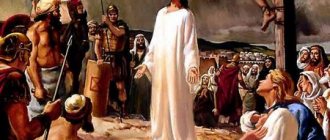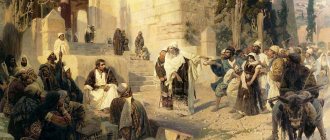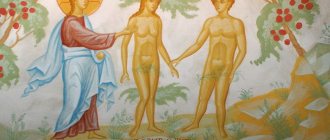| Savior Almighty. Icon of St. Andrei Rublev, 1410-20s. Collection Tretyakov Gallery |
Jesus Christ
,
the Son of God
,
God the Word
,
our Lord and Savior
, the Second Hypostasis of the Most Holy Trinity, according to the eternal advice of God, incarnated for the sake of the salvation of the sinful human race, from the Ever-Virgin Mary, voluntarily accepting suffering and death through crucifixion on the Cross, then resurrected and ascended to the Heaven to come again at the end of time, to judge the world and reign in eternity.
Who is Jesus Christ?
Names
The Holy Scriptures and Holy Tradition, preserved by the Church, contain numerous names of the Lord Jesus Christ, revealing His properties and actions from different angles.
The main ones: Jesus
(Ἰησοῦς) (Greek from Hebrew
Yeshua
(ישוע), consists of the roots of the name of God Jehovah (Yahweh) and the word
shua
- “salvation”) - this name was named according to the word of the Archangel Gabriel (Luke 1:31) when the Lord was born on earth as a man.
This name is interpreted as “God’s help”, “God saves” or “God the Savior” and indicates the purpose of the Incarnation - to save people. Hence another widely used name for Jesus Christ - Savior
or
Savior
(Greek Σωτήρ).
Christ
(Χριστός), also
Messiah
(Μεσσίας) (Greek from Hebrew
Mashiʁach
(מָשִׁיחַ), “Anointed One”) - this is how the prophets called the Lord before His coming to earth, this is how the apostles confessed Him after His coming. This name indicates the anointing with the sacred chrism, through which the gifts of grace of the Holy Spirit are given, and has long been adopted by prophets, high priests and kings. Jesus is called the Anointed One because His human nature was given in the highest degree the attributes of these three offices—the knowledge of a Prophet, the holiness of a High Priest, and the power of a King.
God's Son
(Greek Υἱὸς Θεοῦ) - God the Father Himself called Christ His Son (Ps. 2:7, Matt. 3:17, Matt. 17:5, Luke 3:22). According to His Divinity, as the Second Hypostasis of the Most Holy Trinity, God the Son is pre-eternally (that is, outside the conditions of time) born of God the Father.
Word
(Greek
Logos
(Λόγος), corresponding Hebrew
Memra
(מימדא)) - the Apostle John the Theologian says this about the Divinity of Jesus Christ: “in the beginning was the Word, and the Word was with God, and the Word was God” (John 1: 1). This name reveals the relationship between God the Son and God the Father. On the Greek pagan philosophical load of the concept, see Art. Logos.
Lord
(Greek
Kyrios
(Κύριος), corresponding Hebrew
Adonai
(אֲדֹנָי, literally “my Lords”)) - God the Word is called this many times in the Holy Scriptures, Old (Ps. 109:1) and New (Luke 2:11) Testaments. The name Lord is one of the names of God, and indicates the Divinity of Christ. For more details see Art. Adonai.
| Savior Almighty. Icon gray VI century Sinai Catherine Monastery |
Hypostasis and nature
The Lord Jesus Christ is One Person (Person, Hypostasis) with two natures (essences, natures), Divine and human.
By Divinity
He is the Second Hypostasis of the Most Holy Trinity, pre-eternally (that is, outside the conditions of time) born of God the Father. He is the Only Begotten - that is, the only God the Son born of God the Father (John 1:14). As begotten and not created, He is Consubstantial with God the Father and God the Holy Spirit - that is, it has the same Divine nature as the other two Hypostases of the Trinity. He is Inseparable from God the Father as a Light-ray from a Light-source, as a Word from a Thought or Mind. As the Word reveals Thought, the Son reveals the Father.
By humanity
He is the Son of Man, born of the Ever-Virgin Mary from the line of King David and the forefather Abraham; A man of sorrows, who suffered and died on the Cross; The firstborn from the dead, raised on the third day. In the incarnation, God the Word accepted the fullness of human nature, including both body and soul, remaining alien only to sin. From the very conception in the womb of the Most Blessed Mary, He became Consubstantial with all people, but His human nature is not damaged, but is permeated by the Divine and transformed.
Like a God-man
Jesus Christ is both perfect God and perfect man.
The two natures are united in His single Hypostasis “unfused, unchangeable, inseparable, inseparable
. This means that neither the Divine nor the human nature, as a result of the union, underwent the slightest change; they did not merge and form a new nature; will never separate. Jesus Christ also has two wills: Divine and human. At the same time, His human will agrees with the Divine will in everything.
| Savior Almighty. Mosaic 2nd floor. XI century, Assumption Church of the Daphnian Monastery near Athens |
How Christ confirmed that He is both God and Man
As God, Jesus Christ openly declares His Divine nature. He says: “He who has seen Me has seen the Father” (John 14:9), “I and the Father are one” (John 10:30), “no one knows the Son except the Father; and no one knows the Father except the Son, and to whom the Son wants to reveal it” (Matthew 11:27). To the question of the Jews, “Who are you?” He answers: “He was from the beginning, just as I told you” (John 8:25). Speaking to them about Abraham, He says: “Truly, truly, I say to you, before Abraham was, I am” (John 8:58).
But He also calls Himself the Son of Man. One can and should speak of Him as a man, with the exception of one difference - He is a perfect man, for He has no sin. The human nature of Jesus Christ is consubstantial with ours, but it is completely free from original sin. In Him human nature is again revealed in all its innocence and purity. His human nature is permeated by the Divine, transformed and completely unrelated to sin.
***
Savior in the history of the world
At first
God the Son is coeternal with God the Father and God the Holy Spirit, and exists originally, before the creation of time. At the eternal council of the Most Holy Trinity, when drawing up a plan for the creation and salvation of mankind, He agreed to undertake the incarnation and redemptive feat (Heb. 10:5-7; Eph. 1:4; 1 Pet. 1:20). At the creation of the world, everything that exists was created by the One God the Creator, the Most Holy Trinity, and the Father acted through the Son in the Spirit. Therefore, it is said about Christ that “all things came into being through Him” (John 1:3), “all things were created by Him and for Him” (Col. 1:16).
Old Testament era
After the fall of the first people, Adam and Eve, the human race was damaged by evil - that is, subject to sin, curse and death - and could not correct itself. Then God made the Old Testament with people, promising to give them a Savior. This promise was first given in paradise, and in the name of Christ “The Seed of the Woman” there was a revelation about His seedless conception by the Ever-Virgin Mary (Gen. 3:15). The entire subsequent Old Testament era became a time of preparation for humanity to accept the coming Christ. The people of God, who kept faith in the coming Messiah, formed the Old Testament Church.
Through gradual revelations, prophecies and types, God repeated His promise to people and gave signs by which they could recognize the Savior. Thus, the promise of the Savior was repeated to the forefather Abraham (Gen. 22:18) and King David (2 Sam. 7:12-13) - the ancestors of Christ according to the flesh. Among the numerous Old Testament prophecies about Christ, the clearest and most detailed were given through the prophets David and Isaiah, which is why the Psalter remains the most used in the worship of the Church, and Isaiah is called the “Old Testament Evangelist.” The prototypes of Christ were both people - such as the priest-king Melchizedek, Patriarch Joseph the Beautiful, the prophet Moses the Seer of God and the long-suffering righteous Job - and creatures and objects, starting with the Passover lamb, manna from heaven and the copper serpent. Finally, people of the Old Testament era were repeatedly rewarded with Epiphanies (theophanies), in which God appeared to the world in various guises - most often in the form of an angel or a husband. It is God the Son in the Divine Economy who is the God of Revelation, therefore all the Old Testament appearances of God were phenomena of the Second Hypostasis.
Thanks to God's Providence, saving faith in the coming Savior was invariably preserved among the Jews. However, before the coming of Christ, the law of sin continued to operate, according to which people were unable to accept the gifts of God’s regenerating grace and invariably fell into death after death.
| Crucifixion of the Lord. Icon 1st half. XIV century, Constantinople. Collection Byzantine and Christian Museum of Athens |
First Coming
The Old Testament period of world history ended when the promised Christ the Savior was finally sent by the Father, “came down from heaven” (John 3:13) and came to earth as a man. The purpose of this First Coming of Christ was to save humanity from sin, damnation and death. For this, the Son of God became incarnate from the Holy Spirit and the Ever-Virgin Mary, and became human - that is, he took on a human body and soul. Having united in Himself the natures of God and humanity, the God-man Jesus Christ became the New Adam - the ancestor of a new, deified humanity. His birth according to the flesh took place around 5 BC. e., during the reign of Emperor Octavian Augustus, in Judea conquered by the Romans, in the city of Bethlehem, in a cave intended for cattle stalls. Thus, Jesus Christ “made Himself of no reputation, taking the form of a servant” (Phil. 2:7).
When the Lord Jesus reached the age of 30, he began to teach. The content of His sermon was “The Gospel of the Kingdom of God” (Mark 1:14) - that is, the doctrine of salvation and blessedness. The most important instructions of Christ are concentrated in His Sermon on the Mount (Matthew 5-7). Having chosen his closest disciples - the apostles - He fully showed them the revelation of God by His word and example. To reassure people, the Savior performed many miracles—turned water into wine; healed the sick, crippled and possessed; fed thousands of people with a few loaves of bread; walked on water; with a word he tamed the storm; raised the dead. The Lord exposed the false teaching and lawless life of many leaders of the Jewish people. Having found faith in the disciples and glory among the people, He aroused the envy and hatred of other elders and scribes.
In the third year of His public ministry, just before Easter, the Lord Jesus Christ was betrayed, condemned, mocked, crucified on the Cross and buried outside the walls of Jerusalem. The Savior voluntarily gave Himself to suffering and death. According to His word: “I lay down My life in order to take it up again. No one will take it away from Me; but I myself give it away” (John 10:17-18). By sacrificing Himself for all people, He redeemed humanity and delivered it from the consequences of the Fall. “The chastisement of our peace was upon Him, and by His stripes we were healed” (Isa. 53:5).
Death according to humanity could not kill the Divine. While His body rested in the tomb, the Savior descended in soul to bind the devil there, preach victory over death and lead the souls of the righteous who were waiting for Him to heaven. On the third day, the Lord Jesus Christ was resurrected in an immortal body, becoming “the firstborn of those who died” (1 Cor. 15:20). For forty days He appeared to the apostles, continuing to teach them. Then He ascended into Heaven with His humanity and sat down at the right hand of the Father, so that His human soul and body received the same glory that Christ has in His Divinity. Thus, the Son of God achieved the salvation of people, deifying humanity in Himself and opening the way to the Kingdom of Heaven for all who unite with Him in His Church.
| Savior in hell. Fragment of the fresco “The Resurrection of Christ” (1316-1321). Altar of the Spassky Church of the Chora Monastery of Constantinople (Kariye Museum) |
New Testament era
The appearance and accomplishments of the Divine Savior Jesus Christ established the New Covenant of God with people, according to which humanity is called to live until the Second Coming of Christ. Having ascended into heaven, the Lord did not leave His disciples, but promised to be with us “always, even to the end of the age” (Matthew 28:20). For all those who believe and those who follow Him, He established the New Testament Church, the formation of which was completed by the sending of the Holy Spirit from the Father to the apostles on the tenth day after the Ascension. As the Head, Foundation and Bridegroom of the Church (Eph. 1:22, 1 Cor. 3:11, Eph. 5:22-32), the Lord illuminates, governs, teaches and works savingly in it with His grace. In the sacrament of Communion established by Christ - the core of New Testament worship - He is both the High Priest and the Lamb, “bringing, and offered, and received, and distributed” to introduce the faithful to eternal life. This is how His words are fulfilled again and again: “He who eats My flesh and drinks My blood has eternal life” (John 6:54). The Lord also acts through other sacraments, listens to prayers, has a special presence in the temples of God and in every gathering of people in His name (Matthew 18:20). Finally, He appears to people in a visible way, as was the case with the first martyr Stephen (Acts 7:55-56) and with many saints to this day.
As the omnipresent God the Word, the Lord still provides for the whole world. He carries out private judgment on the soul of each person after his death. Having a special presence in heaven, in eternal glory, He reveals himself to the souls of the righteous: their posthumous bliss is connected with the sight of Jesus Christ. But the Lord will carry out His final judgment on everyone only at the end of this world.
| Savior Not Made by Hands. Icon of the 12th century, Novgorod. Collection Tretyakov Gallery |
Second coming
The second coming of Christ will mark the “end of the age” - the end of the history of the world as we know it. “The times or seasons” (Acts 1:7) of this event are hidden from people, but some signs of its approach are open: a decrease in faith and love between people, an increase in vices and disasters, preaching the Gospel to all nations, the conversion of the Jews to Christ, the coming of the Antichrist ( Matthew 24;Rom 11:25-32). However, despite the known signs, the “day of the Lord” threatens to come “like a thief in the night” (2 Pet. 3:10), which is why the Son of God called the faithful to constant vigilance. The final destinies of the world are described in the most detail, but also most mysteriously, in the Revelation of John the Theologian.
The purpose of the Second Coming of Christ will be judgment and reign over the world. The Lord Jesus will come the second time in the same way as He previously ascended into heaven (Acts 1:11). If the first time He came in humiliation, now He will come in glory, with an army of angels (Matthew 25:31); if for the first time he became like the Lamb, now he will also become like the Lion. Having crushed the Antichrist, He will sit as King and Judge at the Last Judgment. Then the dead will rise, all humanity will gather before Him and everyone’s conscience will be opened. Without partiality, the Lord will divide humanity into “sheep” and “goats”: the first will go into eternal life, and the second into eternal punishment (Matthew 25:31-46, John 5:28-29, 1 Cor. 4:5) .
After the Last Judgment, eternal life will begin in the Kingdom of Christ, which will never end (Luke 1:33).
Why did Christ appear?
As is known, the Good God “created man for incorruptibility and made him the image of His eternal existence” (Wis. 2:23). But man resisted the will of the Creator, and “sin entered into the world, and death through sin” (Rom. 5:12). As a result of the Fall, corruption affected not only the human conscience, but also the human essence itself. Man could no longer give birth to holy and sinless descendants; he became prone to evil, susceptible to the influence of fallen spirits: “Oh, what have you done, Adam? When you sinned, it was not only you who fell, but also us who come from you” (3 Ezra 7:48). The Fall “perverted all the powers of the soul, weakening its natural attractions to virtue” (St. Gregory of Sinai).
Man could only get rid of the power of sin only through the special intervention of Almighty God. And so, revealing His boundless love for mankind, God sends His Son into the world (John 3:16).
There was no other person who had such a profound influence on the development of culture
There was no other person in history who had such a deep, comprehensive and fertilizing influence on the development of human culture. It was Jesus Christ who set the vector of cultural development of several continents for many centuries. Having begun in the Middle East, Christianity very quickly spread throughout Asia Minor and North Africa, then spread to Eastern and Western Europe. Subsequently, Christian civilization covered both Americas, Australia, a significant part of Africa and Southeast Asia. And in each of these regions, Christianity had a huge, in many cases decisive, influence on the development of culture and shaped the cultural codes of entire nations.
Not a single person in history can compare with Jesus Christ in the number of paintings dedicated to him. The total number of images of Christ placed in churches, including scenes from His life, amounts to tens of millions. Add to this all the works of world painting and sculpture dedicated to him, their numerous reproductions on postcards and albums - we can talk about billions of such images.
No single person has had so many pieces of music dedicated to him, from early Christian liturgical music to numerous cantatas and J. S. Bach's majestic Passion. The image of Jesus attracts composers from different countries, times and peoples.








